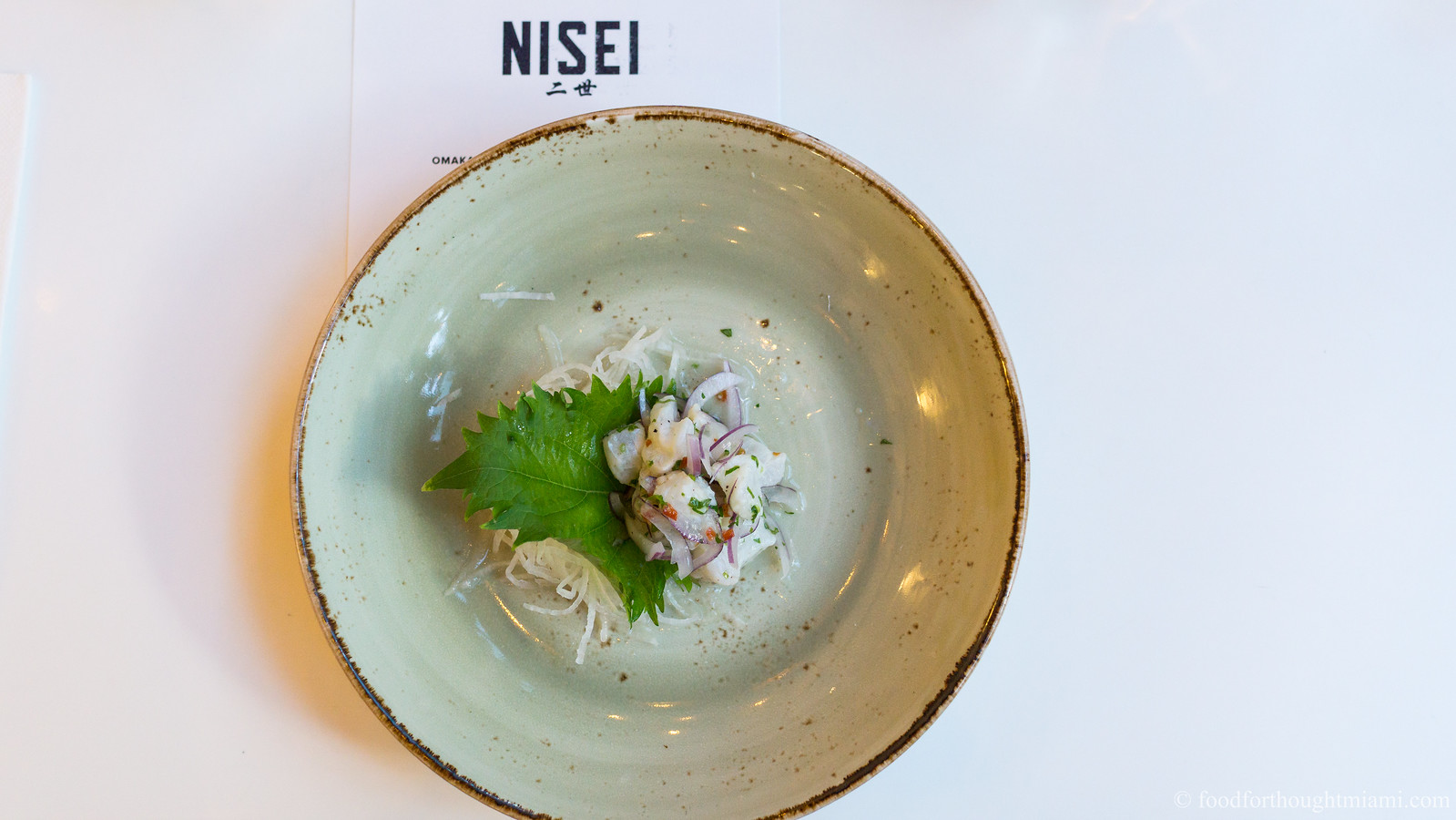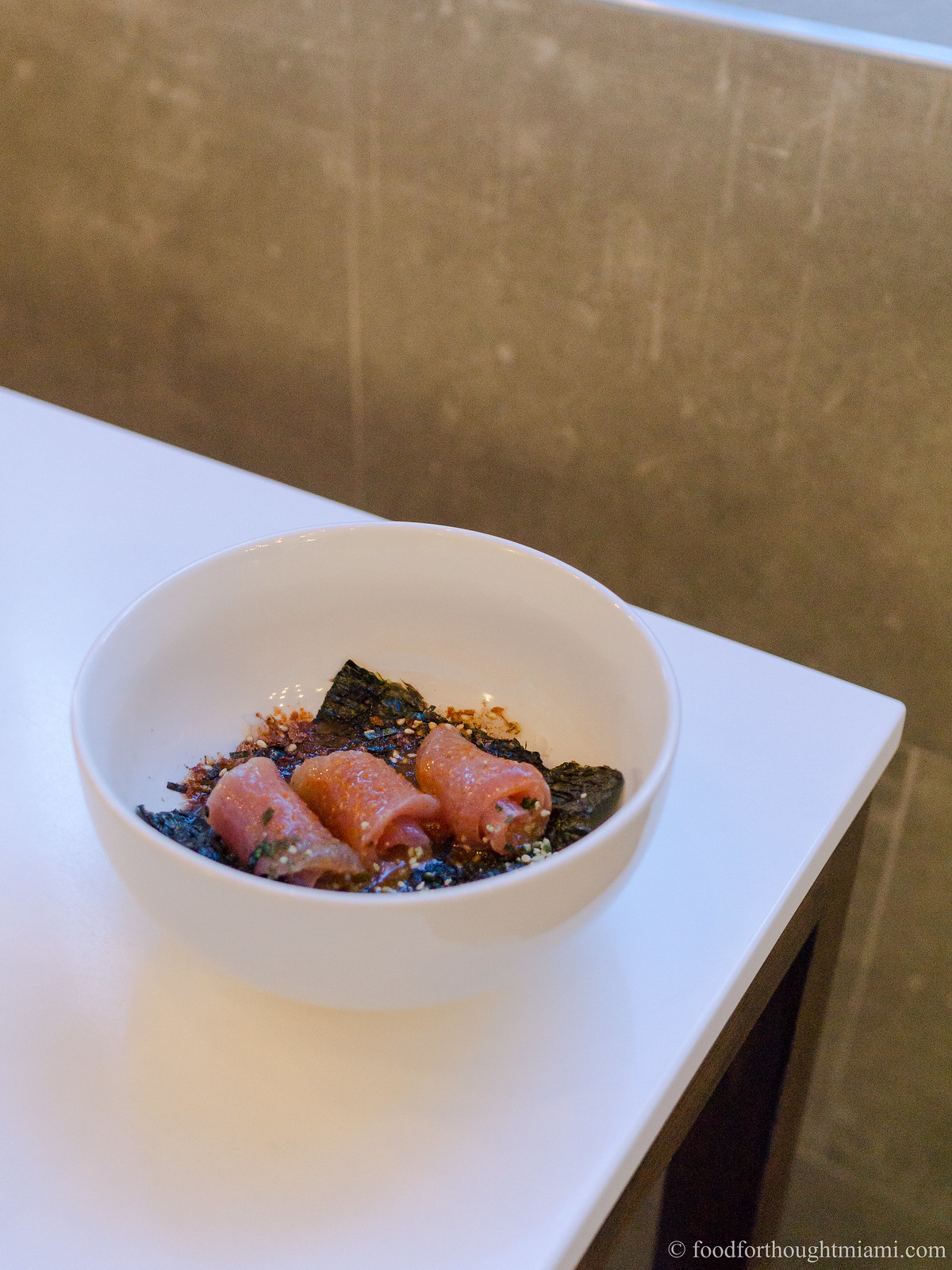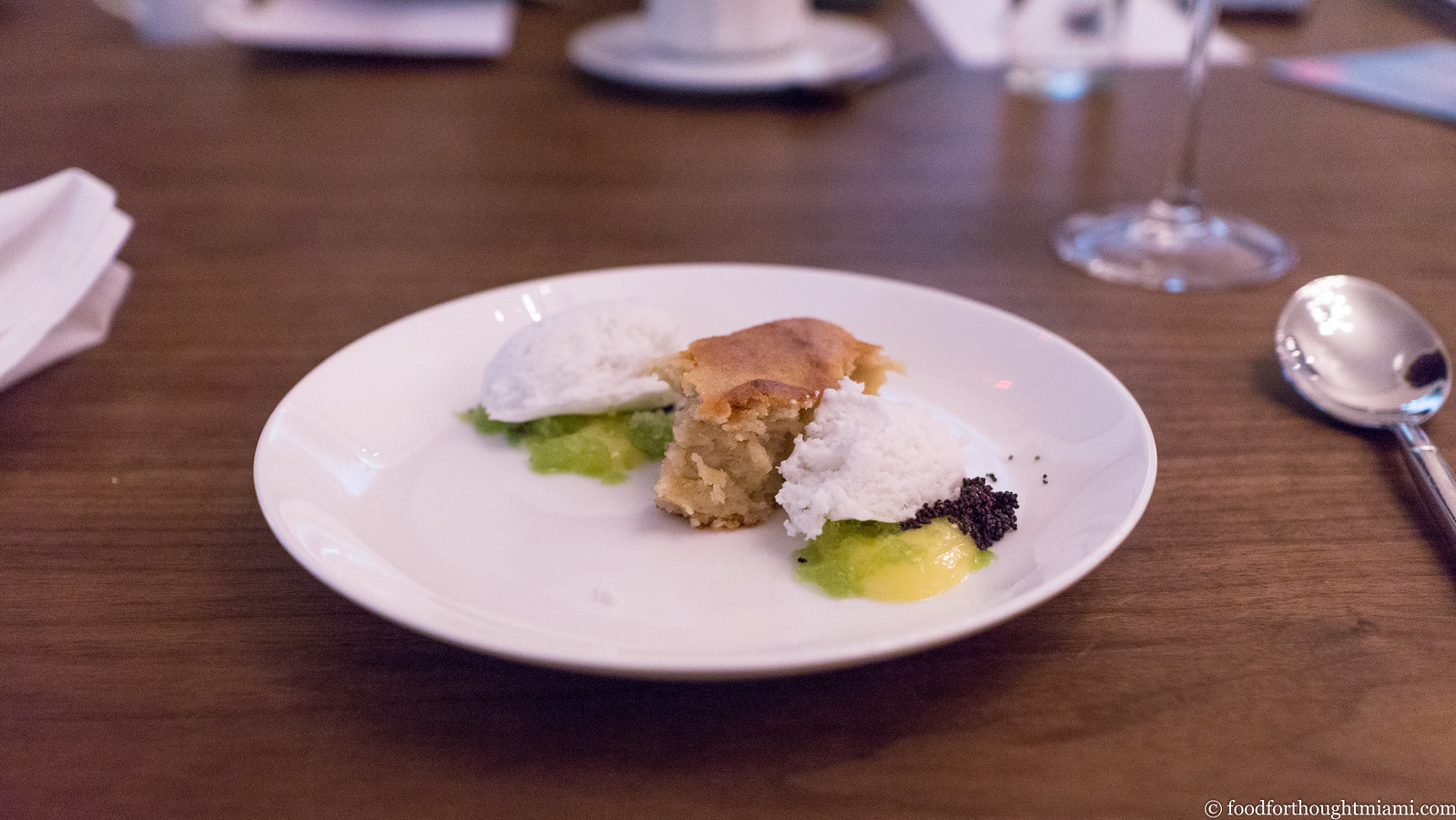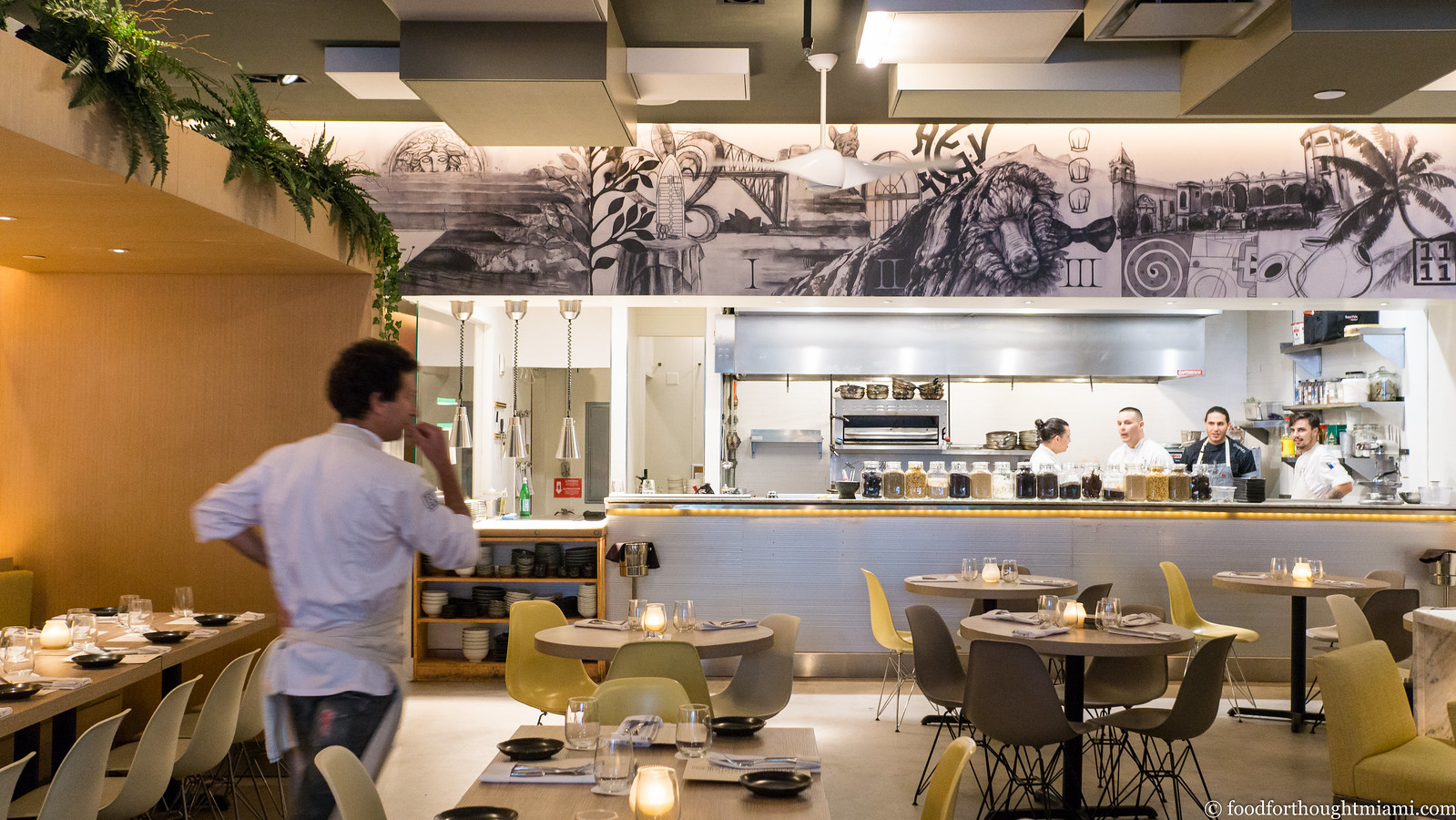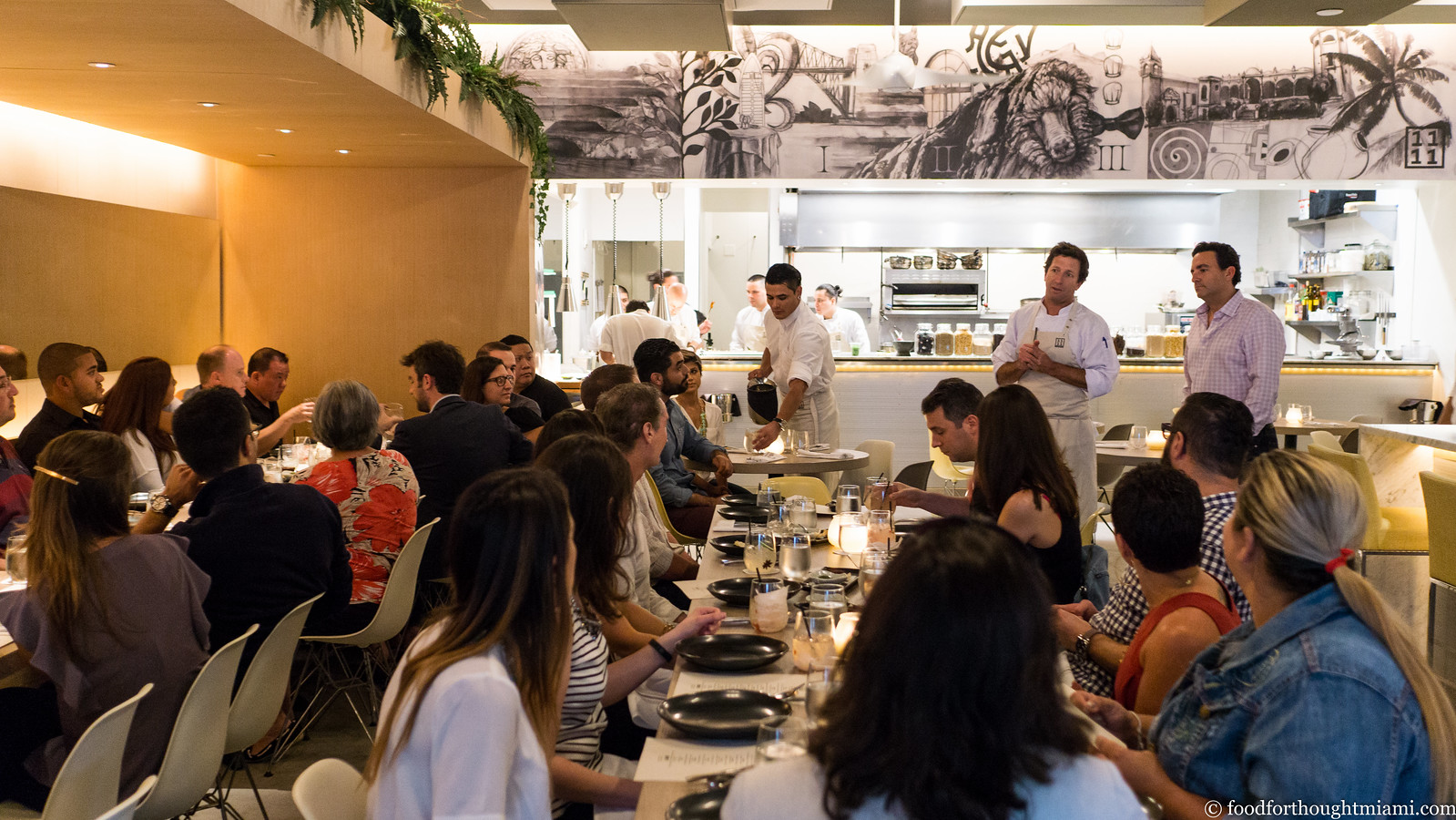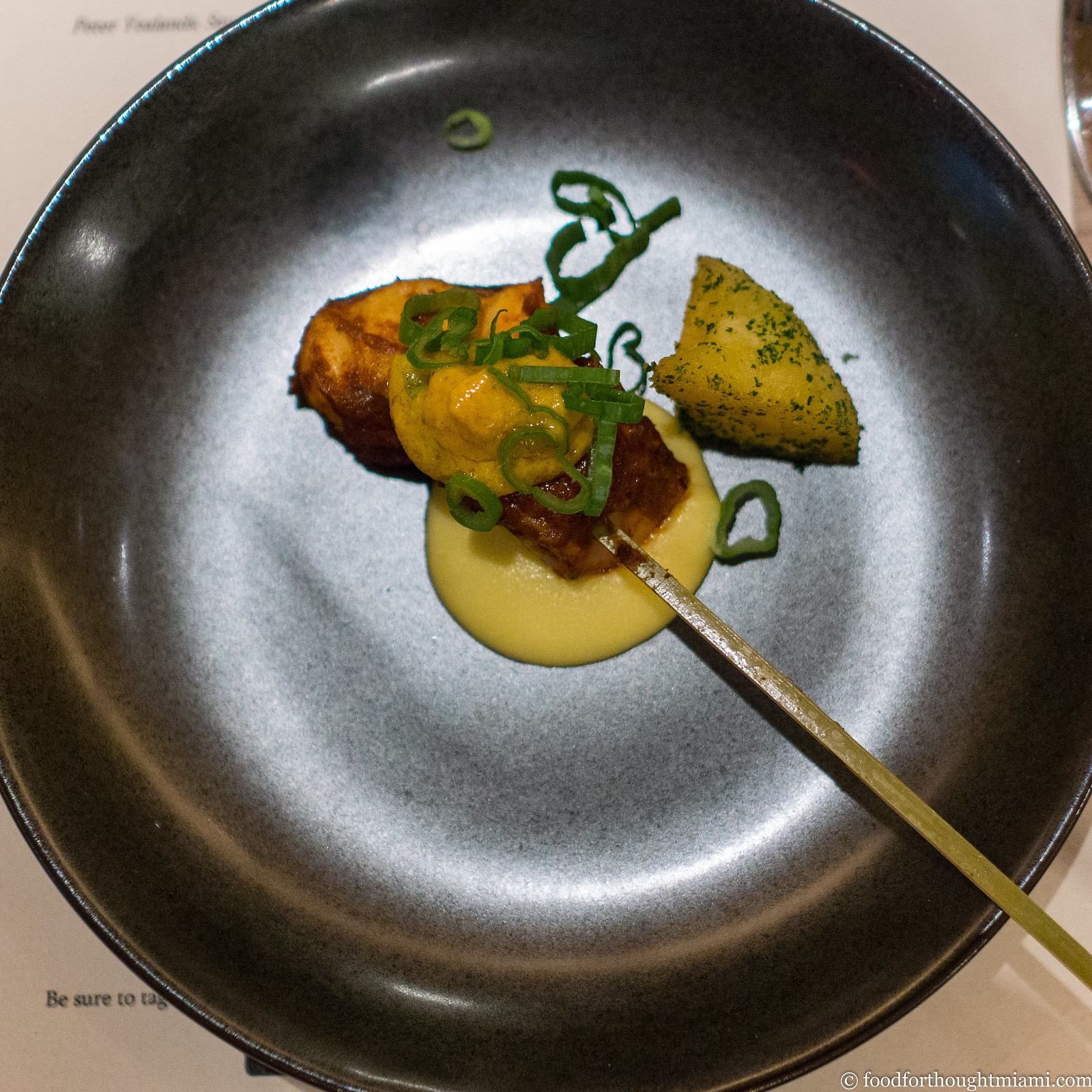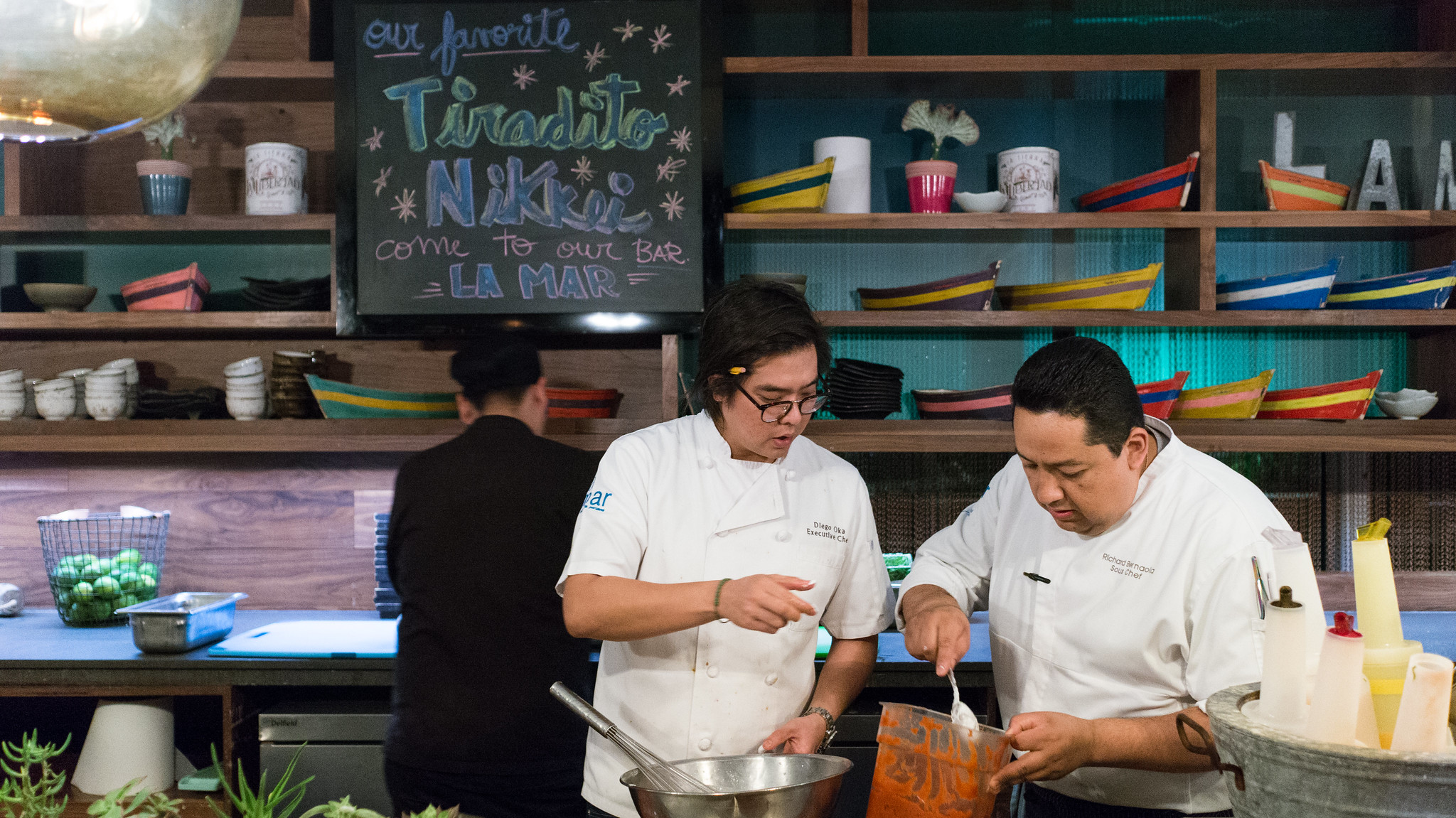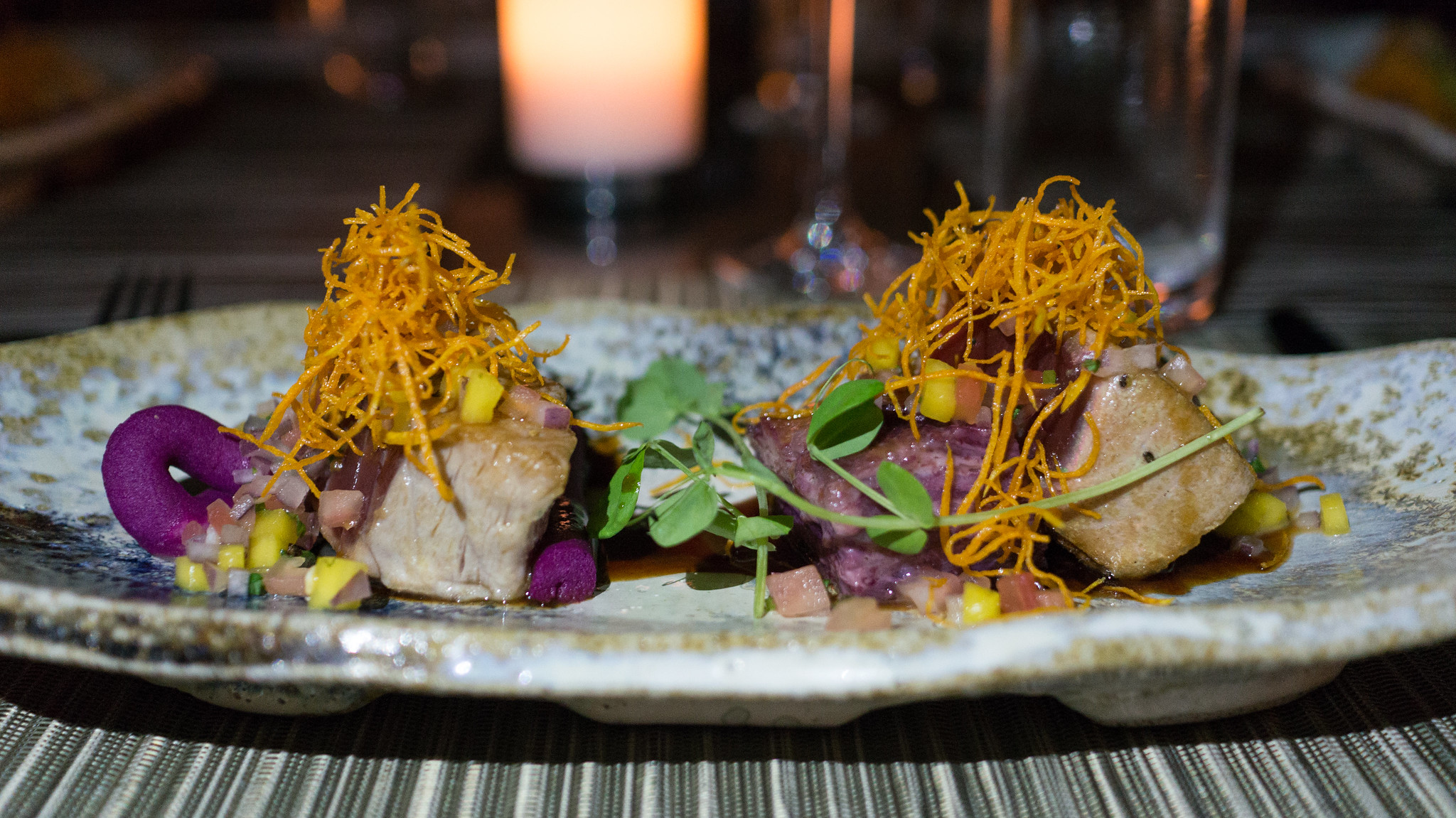Showing posts sorted by date for query mandarin chocolate. Sort by relevance Show all posts
Showing posts sorted by date for query mandarin chocolate. Sort by relevance Show all posts
Monday, July 31, 2017
first thoughts: Nisei | Brickell (Miami)
It's been quiet here at FFT, which is partly just the result of lots of other stuff going on; but it's also a sign that there's not been anything in the Miami food world that's gotten me excited enough to post. Happily, the latter of those issues got fixed this weekend.
The fix was a dinner at "Nisei," a pop-up dinner series which is taking up residence for a couple evening weekends at B Bistro + Bakery[1] in Brickell. It's the product of chef Fernando Chang, who had previously worked at 26 Sushi & Tapas in Surfside, together with Eric Saltzman (formerly of Taquiza and now at Dizengoff),[2] and features an omakase menu of Nikkei dishes fusing Peruvian and Japanese flavors. While this style of cooking is nothing new in Peru, where Japanese culinary influences have long held sway, Nisei's menu brought some smart new ideas and really nice execution, particularly considering our visit was on only the second night of service.
(You can see all my pictures in this Nisei - Miami (Brickell) flickr set).
The meal starts in mostly Peruvian territory: a ceviche of fresh locally caught grouper, marinated in lime juice and bright, spicy aji limo,[3] and flecked with slivered purple onions and cilantro. It's easy to find ceviche in Miami – it's not nearly as easy to find one this fresh and clean.
The next dish nods to both Peru and Japan: the fried shiso leaf is an item you'll find at Japanese tempura houses, but the sandy texture of the crisp fried shell is borrowed from jalea, a classic Peruvian fried seafood dish. The leaf practically dissolves in one bite and a shatter of crumbs, and is served with a sauce that melds sarza criolla (an onion-forward salsa) and aji amarillo. It's good, but what I really want is for them to sandwich some uni in between a couple shiso leaves and then fry it (like so).
The next dish, maguro don, makes it all the way over to Japan, with a stop-off in Korea. Ribbons of lean tuna are mounted on a sheet of soft nori, nestled over short grain rice and kimuchi (an unfermented Japanese style kimchi), amped up with the rippling heat of Peruvian rocoto chile (Peru's not been abandoned entirely) and then rounded out with a bit of honey.
(continued ...)
Friday, December 30, 2016
best dishes of 2016: part 2
It's a tradition, here and everywhere else in the known universe, to do year-end "best of" lists. It's cheesy and facile, but it's also a good opportunity to reflect on the year that's passed – the highs and the lows. In a year that had a brutal number of untimely demises, the Miami restaurant world had some as well. The first four dishes in this Part 2 of my Best Dishes of 2016 (click here for Part 1) were all served at restaurants that are no longer with us.
(You can see pictures of all of the dishes listed in this Best Dishes of 2016 flickr set).
The story picks up here in late February with our second Cobaya dinner in conjunction with the South Beach Wine and Food Fest, which was hosted by Alex Chang at the Vagabond (read my thoughts and see all my pictures from the Cobaya / SoBeWFF dinner). Chang and the Vagabond parted ways several months ago. He's now back out in Los Angeles but still has some Miami connections: he'll be heading up the new Broken Shaker / Freehand restaurant in L.A., The Exchange. But it was actually Andrew Zimmern's dish that was one of my favorites of that meal, and of the year:
Most folks probably know Zimmern from his James Beard Award winning Travel Channel program, Bizarre Foods. What they may not know is that the guy can also flat out cook. In addition to a silky vichyssoise with a citrus-cured oyster that was served as guests gathered around the Vagabond's poolside bar, he also was responsible for my favorite course of the evening: a riff on an Italian classic, vitello tonnato, done here with thin slices of veal tongue, a tangy anchovy-laden dressing, citrus segments, chile oil spiked fried capers and slivered olives for some punch, and crispy chickpea crackers for scooping.
Whenever we do a Cobaya dinner on our own, people generally know they're going to be in for something a bit different and adventurous. But seats at the SoBeWFF dinner get filled by all sorts of folks, including many who may not quite know what they're in for. So one of the highlights of the evening for me was Zimmern making sure to wait until everyone was about four bites into the dish before giving its description, and letting everyone know that he'd used veal tongue. I'd guess that about a quarter of the diners' jaws dropped. It makes me even more grateful for the support and open-mindedness of the group who come out to our regular dinners.
One of the really great things about this event was to see the teamwork of the chefs and their crews in the kitchen. As Carlo Mirarchi and his pastry chef Sam Short started to plate their dessert, everyone else jumped onto the line to help. The end result was outstanding: a nutty, burnt lemon cake, surrounded by a couple globes of coconut "fluff," with puddles of fragrant meyer lemon curd, a sort of celery jam, and sweet poppy seeds. Too often, these savory-leaning desserts feel contrived; but here, everything improbably made perfect sense together.
Another casualty of 2016: Michelle Bernstein's Michy's, which last year renamed itself Cena by Michy (read my thoughts and see all my pictures from Cena). She's still plenty active and engaged, between Crumb on Parchment, a Michy's pop-up for Art Basel, TV gigs, and her work for Common Threads, but it is a real loss to Miami that Bernstein closed what has been one of the city's best restaurants since it opened ten years ago. Nobody cooks foie or sweetbreads like Michy.
The decor and menu have changed at Cena by Michy (f/k/a Michy's), but at least one thing remains the same: if there is a sweetbread dish on the menu at a Michelle Bernstein restaurant, it will be outstanding. Case in point: this sweetbread milanese, like a cloud encased in a crispy shell. It's served with a tangy sort of stew of cherry tomatoes and fennel ribbons, with a wonderful little surprise: pickled strawberries, which provide little jolts of refreshing, sweet-tart contrast.
Michael Pirolo's Bazi, a high-end Asian venture for the chef whose Italian restaurant Macchialina is one of my favorites on the Beach, wasn't around long enough for me to really mourn its closing (read my thoughts and see all my pictures from Bazi). Truth is, I only got there once, for a multi-course "kaiseki" dinner he did for a small seating at the bar. There were several very good dishes, and one in particular stood out.
This is the kind of thing a chef does because they really want to, and maybe because they're a little crazy. Let's not dwell too long on how much this truly resembles a traditional Japanese kaiseki dinner (short answer: not too much). Instead, let's talk about the best thing I ate there: the clams and rice dish Pirolo served as one of the courses.
In this one dish, Pirolo ties together his Italian background and his Japanese ambitions. Diced razor clams are combined with chewy but tender viaolone nano rice, all served in the clam's shell. The rice is prepared in classic "all'onda" fashion, and bound with the clams by an uni vinaigrette which further highlights the flavors of the sea. A shower of fresh lemon balm adds a bright, herbaceous, citrusy note. It's a beautiful dish.
Many of the best things I ate this past year were found in Miami, though not necessarily from Miami chefs. Here's another from an Alter collaborative dinner, this time with Virgilio Martinez of Peru's Central (read my thoughts and see all my pictures from the Alter / Central dinner).
"Valley Between Andes" – I later figured out that Martinez's menu at Central features dishes inspired by the products of different elevations of the Peruvian topography. This one included avocado, tree tomato (a/k/a tamarillo), and kiwicha (amaranth seeds). The avocado was so creamy and rich that it almost ate like tender braised beef, napped with a tangy sauce and speckled with the nutty, quinoa-like kiwicha, with shards of translucent, herb-dotted crackers for some textural contrast.
While the Alter dinners are collaborations, Brad Kilgore and the visiting chefs tend to alternate courses rather than create dishes together. Even so, sometimes the inspiration of working together can cause the identities of each chef to fade into the background. I would have been hard pressed to know if this was Kilgore's or Martinez's dish if I hadn't been following the back-and-forth cadence of the menu.
"Fallen Tree" – Brad started with a caramelized tranche of heart of palm as the base of the dish, with the other components evoking a tropical forest floor: snails, dehydrated mushrooms, a tangle of green (seaweed?) moss, a pouffe of spring garlic mousse with pickled honshimeji mushroom "spores" poking up out of it.
(continued ...)
(You can see pictures of all of the dishes listed in this Best Dishes of 2016 flickr set).
 |
| vitello tonnato - Andrew Zimmern at Vagabond Cobaya / SOBEWFF dinner |
Most folks probably know Zimmern from his James Beard Award winning Travel Channel program, Bizarre Foods. What they may not know is that the guy can also flat out cook. In addition to a silky vichyssoise with a citrus-cured oyster that was served as guests gathered around the Vagabond's poolside bar, he also was responsible for my favorite course of the evening: a riff on an Italian classic, vitello tonnato, done here with thin slices of veal tongue, a tangy anchovy-laden dressing, citrus segments, chile oil spiked fried capers and slivered olives for some punch, and crispy chickpea crackers for scooping.
Whenever we do a Cobaya dinner on our own, people generally know they're going to be in for something a bit different and adventurous. But seats at the SoBeWFF dinner get filled by all sorts of folks, including many who may not quite know what they're in for. So one of the highlights of the evening for me was Zimmern making sure to wait until everyone was about four bites into the dish before giving its description, and letting everyone know that he'd used veal tongue. I'd guess that about a quarter of the diners' jaws dropped. It makes me even more grateful for the support and open-mindedness of the group who come out to our regular dinners.
One of the really great things about this event was to see the teamwork of the chefs and their crews in the kitchen. As Carlo Mirarchi and his pastry chef Sam Short started to plate their dessert, everyone else jumped onto the line to help. The end result was outstanding: a nutty, burnt lemon cake, surrounded by a couple globes of coconut "fluff," with puddles of fragrant meyer lemon curd, a sort of celery jam, and sweet poppy seeds. Too often, these savory-leaning desserts feel contrived; but here, everything improbably made perfect sense together.
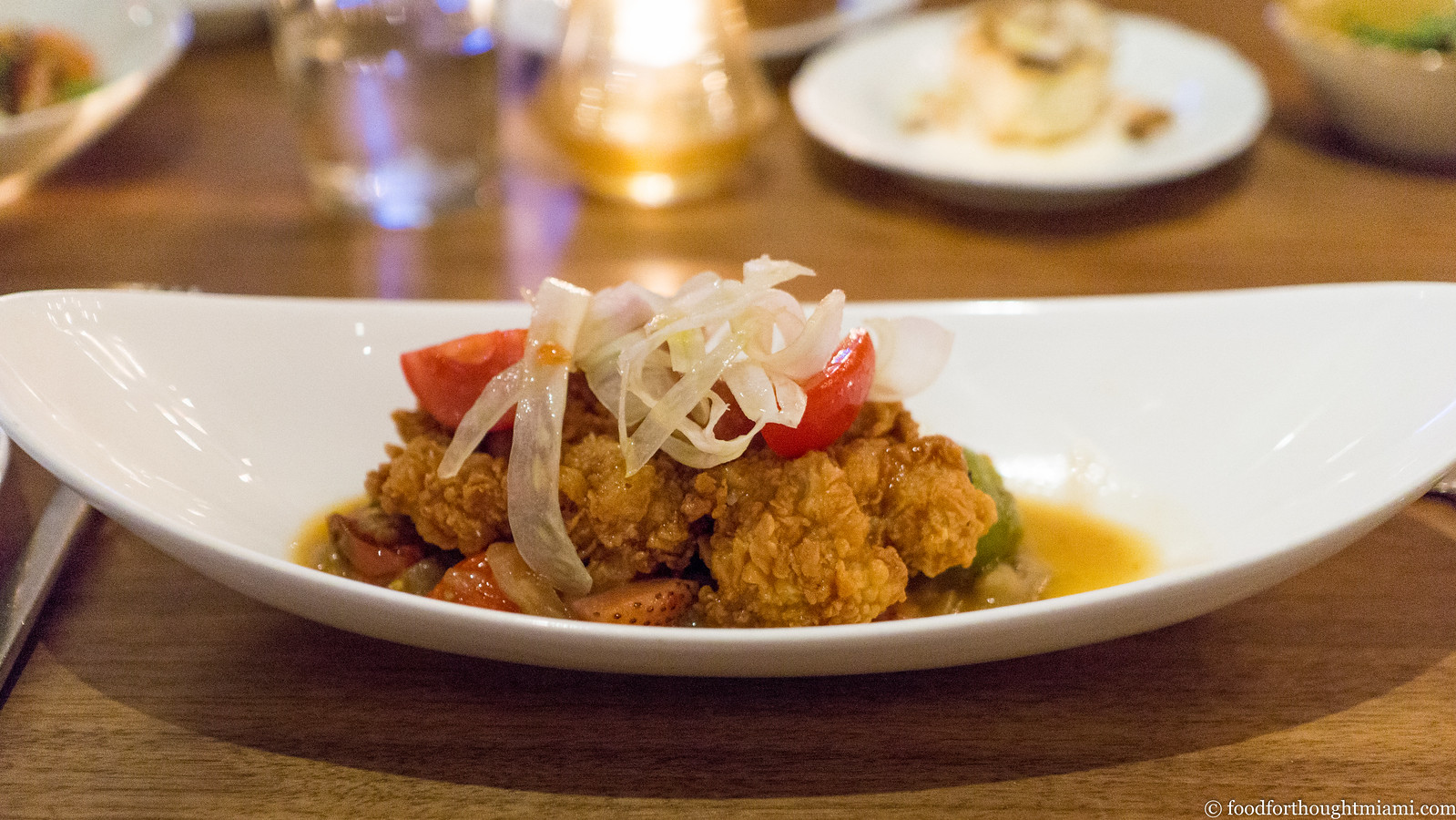 |
| sweetbread, tomato, fennel, pickled strawberry - Cena by Michy |
The decor and menu have changed at Cena by Michy (f/k/a Michy's), but at least one thing remains the same: if there is a sweetbread dish on the menu at a Michelle Bernstein restaurant, it will be outstanding. Case in point: this sweetbread milanese, like a cloud encased in a crispy shell. It's served with a tangy sort of stew of cherry tomatoes and fennel ribbons, with a wonderful little surprise: pickled strawberries, which provide little jolts of refreshing, sweet-tart contrast.
 |
| clams and rice - Bazi |
This is the kind of thing a chef does because they really want to, and maybe because they're a little crazy. Let's not dwell too long on how much this truly resembles a traditional Japanese kaiseki dinner (short answer: not too much). Instead, let's talk about the best thing I ate there: the clams and rice dish Pirolo served as one of the courses.
In this one dish, Pirolo ties together his Italian background and his Japanese ambitions. Diced razor clams are combined with chewy but tender viaolone nano rice, all served in the clam's shell. The rice is prepared in classic "all'onda" fashion, and bound with the clams by an uni vinaigrette which further highlights the flavors of the sea. A shower of fresh lemon balm adds a bright, herbaceous, citrusy note. It's a beautiful dish.
 |
| valley between Andes | avocado, tree tomato, kiwicha - Alter / Central dinner |
"Valley Between Andes" – I later figured out that Martinez's menu at Central features dishes inspired by the products of different elevations of the Peruvian topography. This one included avocado, tree tomato (a/k/a tamarillo), and kiwicha (amaranth seeds). The avocado was so creamy and rich that it almost ate like tender braised beef, napped with a tangy sauce and speckled with the nutty, quinoa-like kiwicha, with shards of translucent, herb-dotted crackers for some textural contrast.
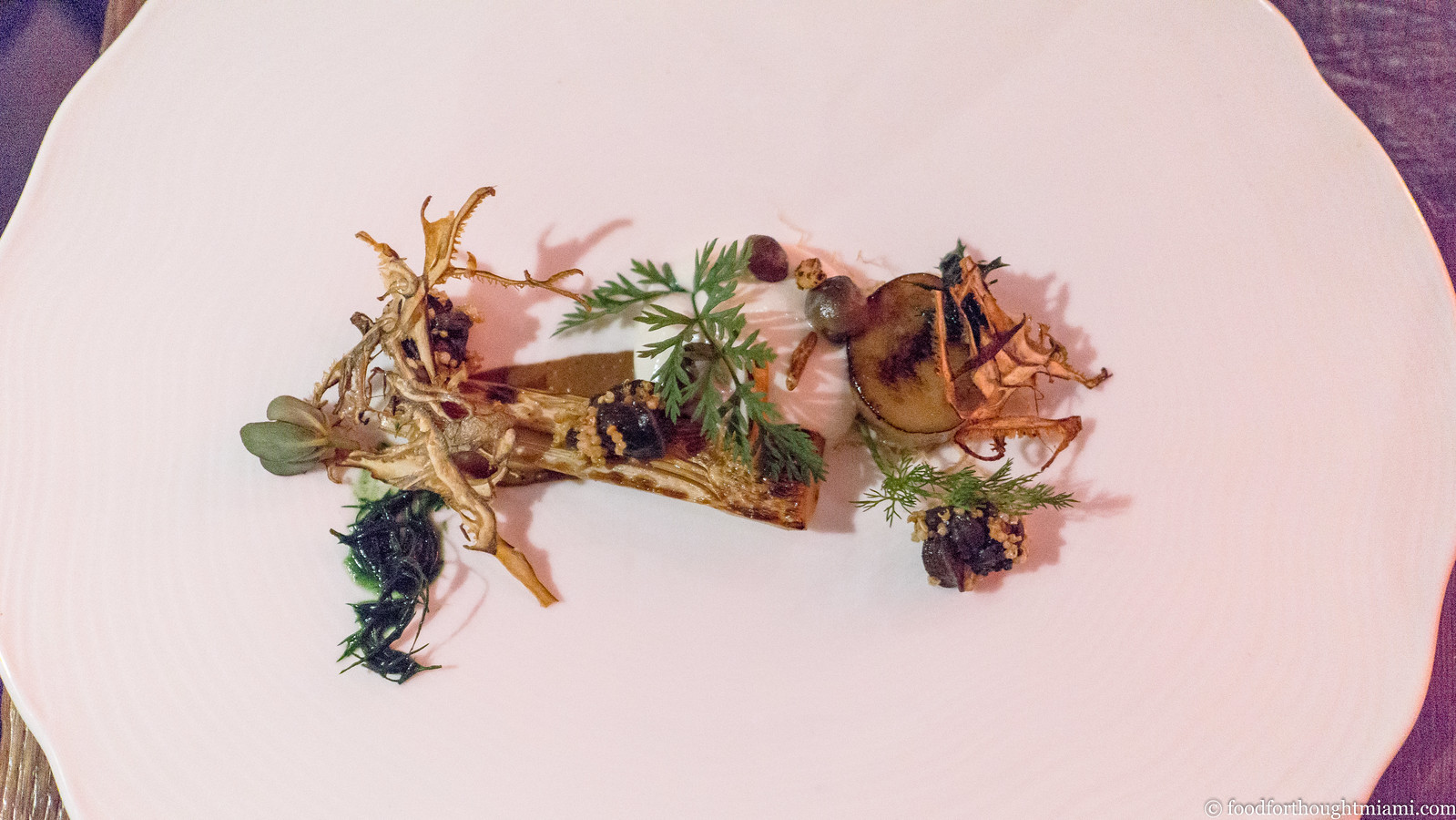 |
| fallen tree | heart of palm, snails, fungi, moss, spores - Alter / Central dinner |
"Fallen Tree" – Brad started with a caramelized tranche of heart of palm as the base of the dish, with the other components evoking a tropical forest floor: snails, dehydrated mushrooms, a tangle of green (seaweed?) moss, a pouffe of spring garlic mousse with pickled honshimeji mushroom "spores" poking up out of it.
(continued ...)
Monday, August 8, 2016
best thing i ate last week: orange chocolate souffle at Pinch Kitchen
I'm not much of a dessert person, but there are certain things that hit certain spots for me. The combination of orange and chocolate is one of them, going back to a childhood fondness for the mandarin chocolate sherbet at Baskin Robbins (the flavor was discontinued many years ago, but memories persist). So when I see a dessert with orange and chocolate, I have trouble not ordering it.
Somehow I missed it on my first visit to Pinch Kitchen, a new-ish restaurant opened up on the northern periphery of the "MiMo District" along Biscayne Boulevard by a couple Pubbelly alumni, John Gallo and Rene Reyes. But their short list of desserts includes an orange and chocolate soufflé, baked right inside hollowed out oranges, and served with a classic creme anglaise. I went back for brunch this weekend to try it (and a couple other things).
The soufflé is airy and light but intense with chocolate flavor, drawing some extra citrus perfume as you scrape your spoon across the inside of the orange skin. I don't know if Baskin Robbins is ever bringing back mandarin chocolate sherbet, but this is a good substitute.
Also very good: a wahoo tartare from the daily specials at Pinch, given some tangy brightness from a fine brunoise of fresh peach, and some zing from fresh red chiles.
(There are a few more pictures in this Pinch Kitchen - Miami flickr set).
Pinch Kitchen
8601 Biscayne Boulevard, Miami, Florida
305.631.2018
Wednesday, June 22, 2016
Cobaya Muñoz at 1111 Peruvian Bistro
Diego Muñoz is a superstar chef. He spent the first part of his career working at some of the world's top restaurants: the Adriàs' El Bulli and Andoni Luis Aduriz's Mugaritz in Spain, Pascal Barbot's Astrance and Guy Martin's Grand Vefour in France, Massimo Bottura's Osteria Francescana in Italy, then off to Australia at Bilson's in Sydney. After literally cooking his way around the world, he returned home to Peru, where he ran the kitchen at Gaston Acurio's high-end tasting menu flagship, Astrid y Gaston, for four years. During Muñoz's tenure, Astrid y Gaston worked its way from No. 42 to No. 14 on the much-hyped (and much-criticized) S. Pellegrino World's 50 Best Restaurants list. When Ferran Adrià was in town last year for a "Gastronomy Congress" at Miami Dade College, Muñoz was one of the chefs on stage doing a demonstration, along with David Gil and Fran Agudo of brother Albert Adrià's restaurant, Tickets.
Then at the beginning of this year, Muñoz left Astrid y Gaston, with plans to embark on another year of world-wide cooking adventures. So when I stumbled across a small Peruvian restaurant that Muñoz had opened a few months ago in Miami, with no fanfare whatsoever – well, surprised would be an understatement.[1] We put the Cobaya wheels in motion to set up a dinner, which we were able to schedule while Muñoz would be in town this Friday.
Muñoz's restaurant, 1111 Peruvian Bistro, occupies the space that used to be home to BoxPark,[2] in the ground floor of the Axis Brickell condo building. It looks much the same, the most notable addition being a mural across the top of the open kitchen which appears to track Muñoz's career – I recognized the El Bulli bulldog, that shaggy sheep looks like the ones roaming the Basque countryside outside Mugaritz, the bowtie must belong to Tony Bilson, and there's Casa Moreyra, which houses Astrid y Gaston. At the end, beyond the palm tree, is 1111.
(You can see all my pictures in this Cobaya Muñoz at 1111 Peruvian Bistro flickr set).
Once we got everyone settled into a few communal tables, Chef Muñoz introduced himself to the group, and servers started bringing out the first round of an eight-plus course dinner.
Many food cultures have their versions of meat-on-a-stick. For Peruvians, it's anticuchos. Veal or beef heart may be the most traditional, but it could be just about anything: chicken livers, steak, fish, shrimp, or, as here, octopus. The meat had a nice spring to it without being chewy or bouncy, It had been rubbed with an anticuchera sauce bright with chiles, vinegar and spices, and was served over a creamy corn purée with a crispy potato alongside and a dab of salsa carretillera on top.
Peru's most famous dish, though, is surely ceviche. But Muñoz is not a traditionalist: he has made ceviches of sea urchin, clam, apple, melon, avocado, and I'm sure any number of other ingredients. Here, the base was the customary cubed whitefish, but it came swimming in a creamy, tangy leche de tigre, garnished with soft chunks of avocado and potent sliced fresh chiles, then given an Italian accent with briny capers and a drizzle of olive oil. It was a very good ceviche, and oddly reminiscent (in a good way) of a vitello tonnato.[3]
(continued ...)
Monday, December 22, 2014
Cobaya Diego at La Mar
It was big news when Gaston Acurio – Peru's most famous and celebrated chef – decided to open a restaurant in Miami. But Acurio has literally dozens of restaurants around the world; he's clearly not cooking in all of them at the same time. At Miami's La Mar, the executive chef responsibilities fall to Diego Oka. In an Edible South Florida piece last year, I recounted Diego's introduction to Acurio as a nervous 16 year old peeking around the corner of a supermarket aisle. He was invited to visit Acurio's restaurant the next day, and pretty much never left. After working with Acurio in Peru, he opened La Mar Cebicheria Peruana in San Francisco with him, then came to Miami to open our own version of La Mar.
Perhaps unlike many other U.S. cities (including San Francisco), Peruvian cuisine is nothing new here. In fact, South Florida already had over 200 Peruvian restaurants when I last counted, as La Mar was opening. But there are few, if any, places, that show the same creativity and attention to ingredients as are on display at La Mar. We got a preview of what Diego could do when he went off-menu at our Cobayapalooza dinner in July, and were eager to see more.
Last week a small group of guinea pigs assembled on the patio behind La Mar in the Mandarin Oriental, overlooking the lights of downtown Brickell across a sliver of Biscayne Bay. After some Pisco Sours to set the mood, Diego served up seven courses that were simultaneously creative and grounded in Peruvian flavors.[1]
(You can see all my pictures in this Cobaya Diego flickr set – apologies for the wonky artificial lighting, but the dark outdoor setting left me with no choice).
The menu started with a tiradito – a dish reflective of the mingling of local and Japanese food traditions that leads many to call Peruvian food the original "fusion cuisine" (indeed, el jefe Gaston Acurio recently published a book called "500 Years of Fusion"). Typically prepared with sashimi-style slices of raw fish that are then bathed in a ceviche-style citrus and chile bath, Diego's version here used slices of raw scallop, tongues of uni and brilliant orange salmon roe, all napped with a creamy rocoto chile leche de tigre.
Another modern iteration of a traditional Peruvian dish followed: a potato causa made with luridly hued purple potatoes, paired with blocks of seared tuna, a green mango chalaca sauce and crispy sweet potato strings.
(continued ...)
Saturday, September 8, 2012
Cobaya St. Regis with Chefs Richard Gras and Antonio Bachour
In a recent column for the San Francisco Chronicle, restaurant consultant (and former Square One and Chez Panisse chef) Joyce Goldstein bemoans the prevalence of what many pejoratively call "tweezer food." She imagines "an underground team of tiny elves with tweezers, carefully placing tiny little pieces of food in regimented lines across plates all over the country" and rails, "Where is the passion and energy?"
It is, of course, a false dichotomy. Attention to detail and passion are not opposites, nor are they even somehow mutually exclusive. Food that is delicate, or technical, even artful, can and often is prepared with every bit as much passion and energy as any long-simmered braise or sizzling sauté.
There is no better evidence than the dinner that the crew at the J&G Grill[1] in the St. Regis Bal Harbour put together for our Cobaya "underground" dining group earlier this week. The restaurant's chef de cuisine Richard Gras, executive pastry chef Antonio Bachour, and hotel executive chef Jordi Valles[2] do elegant, careful, graceful work; I'm sure tweezers are part of their kitchen arsenal. Yet I have never met any chefs who have more passion for food, more energy, more drive to please and excite than Richard, Antonio and their team.
The St. Regis opened at the beginning of the year;[3] but while high-end travelers have been flocking in droves, I suspect many locals haven't found their way inside yet. They're missing out. Our Cobaya meal was, as we always hope they will be, an off-menu experience, so don't expect to find something exactly like this on any given Tuesday. But some tremendous talent resides in the kitchen there, and we were glad for the opportunity to showcase it.
(You can see all my pictures in this Cobaya St. Regis flickr set, or click on any picture to enlarge it).
They set up our group of 34 at one long table in a space downstairs from the main restaurant; the same beveled rectangles of mirrors that line the hotel's lobby provided an elegant backdrop.
Though our table was some distance away from the kitchen, an A/V hookup, with two massive flat-screens, provided the opportunity for the guests to see and hear the chefs at work, explaining dishes as they were being prepared and plated.
The dinner service started with a one-biter, a spherified beet gazpacho "explosion" served over crumbles of a lemon thyme infused pound cake - the brilliant color matched by a burst of flavor.
(continued ...)
Thursday, July 28, 2011
Spiceonomics v.2011 (Part I)
It's that season again: Miami Spice season. For the next two months, diners go hunting for $35 dinner bargains, restaurateurs squeeze every bit of fat out of their food costs, line cooks go quietly crazy cranking out the same three items over and over again, and servers look forward to the generosity of their penny-pinching customers. Ah, what fun.
We've been over this before here, but to quickly reiterate my rules for navigating Miami Spice season: (1) there's no reason to bother with restaurants where a $35 menu is not a meaningful discount from their regular prices (though, of course, go to them if you like them; just don't do so because they're offering a Miami Spice menu); (2) the infamous chicken breast/farmed salmon/churrasco (or substitute short rib) "trifecta" is usually a tell; and (3) look for food that actually interests you. If a restaurant doesn't excite you the other 11 months of the year, it is unlikely there's going to be something really inspiring on their Spice menu.
As I've done the past couple years, here is a list of some places that look like they may be worth a visit based on the menus they've posted. Again, I'm not necessarily even listing all the choices on their menus, just putting together a meal I might eat. Note as well that I've not tried any of these yet, menus may change, there's still plenty of places you can get a good meal for $35 that don't do Miami Spice, and you might just have a more satisfying meal if you simply go to a nice restaurant and order what you like. Having said that, let's start with South Beach (the restaurant name links to their Miami Spice page so you can gander each restaurant's entire Spice menu if you wish):
(continued ...)
Monday, April 11, 2011
Room 4 Dessert 2 Pop-Up w Chef Will Goldfarb
I suspect when you're around Chef Will Goldfarb, you often feel like you're playing catch-up. He always seems to be about three steps ahead - he thinks fast, he moves fast, he works fast. Last week, he made a quick stop in Miami for a one day pop-up, dubbed "Room 4 Dessert 2." The name, anyway, is a spin-off from his well-regarded if brief-lived New York dessert-and-drinks place from about five years ago, but trying to keep track of everything Chef Goldfarb has done is a bit like trying to nail jelly to a wall - a stage at El Bulli, a tour of Australia including work with Tetsuya Wakuda, back to the U.S. at Morimoto in Philadelphia, Cru in New York, his own sandwich shop, Picknick, a sojourn in Bali to work as pastry chef at Ku De Ta, a business supplying provisions for the contemporary cupboard, WillPowder, and the list continues to go on.
Chef Goldfarb is an unabashed practitioner of what goes by the various misnomers of "molecular gastronomy," "science cooking," or most recently "modernist cuisine."[1] Which is simply to say that he eagerly uses any and all ingredients or techniques available to him - hydrocolloids, gelling agents, emulsifiers, stabilizers, liquid nitrogen, and so on (much of this stuff is conveniently available for purchase at WillPowder).
It's interesting to me that even less adventurous diners seem to take a little less umbrage to the use of such things in a dessert format. When used in savory courses, you often hear complaints that people don't like their food "manipulated" and that it doesn't "look like" food any more. But we're already accustomed to eating desserts that are manipulated, and to using processed ingredients in desserts that don't taste good on their own (baking powder, cocoa, or even flour for that matter). Everybody loves a chocolate mousse, but very few people think about the processing of the ingredients that leads to its creation, or complain that it doesn't resemble its "natural" form. As Chef Alex Stupak (former pastry chef at wd~50, now running his newly opened taqueria, Empellon) put it: "Birthday cake is the most denatured thing on earth."
Here's a run-down of the event; you can see all of my pictures in this R4D2 flickr set. You can also get a look from inside the kitchen via Chadzilla, and another take on it from Mango & Lime.
(continued ...)
Chef Goldfarb is an unabashed practitioner of what goes by the various misnomers of "molecular gastronomy," "science cooking," or most recently "modernist cuisine."[1] Which is simply to say that he eagerly uses any and all ingredients or techniques available to him - hydrocolloids, gelling agents, emulsifiers, stabilizers, liquid nitrogen, and so on (much of this stuff is conveniently available for purchase at WillPowder).
It's interesting to me that even less adventurous diners seem to take a little less umbrage to the use of such things in a dessert format. When used in savory courses, you often hear complaints that people don't like their food "manipulated" and that it doesn't "look like" food any more. But we're already accustomed to eating desserts that are manipulated, and to using processed ingredients in desserts that don't taste good on their own (baking powder, cocoa, or even flour for that matter). Everybody loves a chocolate mousse, but very few people think about the processing of the ingredients that leads to its creation, or complain that it doesn't resemble its "natural" form. As Chef Alex Stupak (former pastry chef at wd~50, now running his newly opened taqueria, Empellon) put it: "Birthday cake is the most denatured thing on earth."
Here's a run-down of the event; you can see all of my pictures in this R4D2 flickr set. You can also get a look from inside the kitchen via Chadzilla, and another take on it from Mango & Lime.
(continued ...)
Friday, July 30, 2010
(Miami) Spice of Life
Yes, it's that time of year again - when diners go off in search of the elusive $35 dinner that does not involve the same boring roll call of chicken paillard, farmed salmon, and churrasco, served by sneering waitstaff who seem less than eager to get into the spirit. Or, to look at it another way, the season when line cooks go slowly insane, chanting "All work and no play makes Jack a dull boy" as they crank out the same couple of dishes over and over again, while the owners calculate food costs down to the penny in the hope they're at least coming out even, and servers put up with customers expecting to be treated like royalty for their meager $5 per person tip. Ahh, Miami Spice time!
We've been through this before here, but I'll briefly repeat my basic rules for navigating Miami Spice season: (1) there's no reason to bother with restaurants where a $35 menu is not a meaningful discount from their regular prices (though, of course, go to them if you like them; just don't do so because they're offering a Miami Spice menu); (2) the infamous chicken breast/farmed salmon/churrasco (or substitute short rib) "trifecta" is usually a tell; and (3) look for food that actually interests you. If a restaurant doesn't excite you the other 11 months of the year, it is unlikely there's going to be something really inspiring on their Spice menu. I like to see it as a chance to try some places, both new and old, that may not be in your "regular rotation," with limited financial commitment.
There's been some good Miami Spice chatter on the interwebs already, with New Times' Short Order playing "Deal or No Deal,"[1] and MRPR's highly amusing and mostly on-target "Open Letter on the Eve of Miami Spice."[2] So with that said, and with the disclaimer that I've not yet tried any of these menus nor indeed all of these restaurants, here are some Spice menus that looked intriguing to me. I may not have listed all the items, but have linked to each of the menus so you can peruse yourself; and keep in mind as well that many places change their Spice menus regularly, if for no other reason than to keep their line cooks from hurting themselves or others.
(continued ...)
We've been through this before here, but I'll briefly repeat my basic rules for navigating Miami Spice season: (1) there's no reason to bother with restaurants where a $35 menu is not a meaningful discount from their regular prices (though, of course, go to them if you like them; just don't do so because they're offering a Miami Spice menu); (2) the infamous chicken breast/farmed salmon/churrasco (or substitute short rib) "trifecta" is usually a tell; and (3) look for food that actually interests you. If a restaurant doesn't excite you the other 11 months of the year, it is unlikely there's going to be something really inspiring on their Spice menu. I like to see it as a chance to try some places, both new and old, that may not be in your "regular rotation," with limited financial commitment.
There's been some good Miami Spice chatter on the interwebs already, with New Times' Short Order playing "Deal or No Deal,"[1] and MRPR's highly amusing and mostly on-target "Open Letter on the Eve of Miami Spice."[2] So with that said, and with the disclaimer that I've not yet tried any of these menus nor indeed all of these restaurants, here are some Spice menus that looked intriguing to me. I may not have listed all the items, but have linked to each of the menus so you can peruse yourself; and keep in mind as well that many places change their Spice menus regularly, if for no other reason than to keep their line cooks from hurting themselves or others.
(continued ...)
Tuesday, January 12, 2010
CSA Week 5 - Black Sapote Ice Cream
Ice cream machine! Ice cream machine! Yes, as warned, I decided it was time to break out the ice cream maker to deal with the black sapotes in last week's CSA bag. The basic recipe: flesh of two ripe black sapotes; 1 cup heavy cream; 1 cup milk; about 1/3 cup sugar (I happened to have sitting around some extra sugar which had been used to coat some candied orange peels, which was imbued with the scent of the oranges' oil, and used that); zest of one clementine. (I was aiming roughly for the flavor profile of the long-gone Baskin-Robbins mandarin chocolate sherbet, the odes of which I've previously sung). Mixed well to incorporate the sapote into the cream, chilled, and then into the ice cream maker.
I'm actually pretty pleased with the results. The flavor of the sapote is perhaps somewhat indistinct, possibly because I'm not accustomed enough to it to recognize it. But there are some dark chocolatey notes, as well as some dark fruit notes like date or dried fig. The orange is not overwhelming but is noticeable and lightens up the flavor some. If I were to be generous, I might say the flavors are reminiscent of a port. I might try a little agar-agar next time to improve the texture. I tried it with a spoonful of arequipe, a Colombian dulce de leche type product with coconut that I found in the grocery store; not bad. I may also try with some candied kumquats to up the chocolatey/citrusy quotient.
The real test will come when I have the kids try it tonight.
I'm actually pretty pleased with the results. The flavor of the sapote is perhaps somewhat indistinct, possibly because I'm not accustomed enough to it to recognize it. But there are some dark chocolatey notes, as well as some dark fruit notes like date or dried fig. The orange is not overwhelming but is noticeable and lightens up the flavor some. If I were to be generous, I might say the flavors are reminiscent of a port. I might try a little agar-agar next time to improve the texture. I tried it with a spoonful of arequipe, a Colombian dulce de leche type product with coconut that I found in the grocery store; not bad. I may also try with some candied kumquats to up the chocolatey/citrusy quotient.
The real test will come when I have the kids try it tonight.
Monday, March 16, 2009
Goizeko Wellington - Madrid

For our final meal in Madrid before heading north to San Sebastian, we went to Goizeko restaurant, part of the Goizeko Gaztelupe group which includes five restaurants in Madrid and Bilbao under the supervision of Chef Jesús Santos. Yes, I know it's odd to be going to a Basque place in Madrid, right before we head off to Basque country, but it was recommended by a dear client whose opinions I trust, and we were looking for something lighter and seafood-focused before hopping on a plane the next day. Besides which, our San Sebastian meals were going to be more on the alta cocina (or should I say "modern gastronomy") side of things, so Goizeko provided an opportunity for more traditional Basque fare, though still with some updated contemporary flair. It all worked out just fine.
Goizeko is located in the Hotel Wellington in the Salamanca neighborhood, but you would have no idea it was there unless you knew to ask. We did so at the front desk, and were steered through the posh lobby lounge to a small door literally at the very back of the room, which but for a tiny sign reading "Goizeko" might have been a broom closet for all appearances' sake. When we emerged on the other side, we walked into a restaurant that was more airily modern than the rest of the hotel, with mostly cream and gold and light wood surfaces all over. This is a fairly sizable hotel restaurant and business was pretty quiet while we were there (on a Tuesday night), though there was a large group of diners in a private upstairs room.
We started off with something I've long wanted to try, percebes de Cedeira. Percebes, a/k/a goose barnacles, are harvested along the coast of Galicia (apparently with no small degree of drama and peril) and look somewhat like an amputated alien claw or limb (as you can sort of see from the photo above - sorry no actual pix from the restaurant). An order for two people brought roughly a couple dozen of these beautiful but strange-looking (and expensive) things. As we dumbly stared and marveled like the apes before the monolith, our server deduced that we'd never had them before and happily (1) retrieved bibs; and (2) showed us what to do. Eating percebes involves bending them to snap through the shell of the tube part - "abajo!" ("down!"), our server quickly cautioned me to avoid spraying myself with its juices - which exposes a little nubbin of meat inside. The texture is just slightly resilient and bouncy, not so much as a clam, almost more like a cooked mushroom, and the taste is just like the unbridled essence of the sea - briny, with a tiny whiff of iodine, and utterly pleasing. We absolutely loved these.
I followed the percebes with an app that was a variation on an ensaladilla rusa. For some reason that I don't fully understand myself, I am mental for the salad rusa or "Russian Salad," a concoction of cubed cooked potatoes, carrots and peas bound together generously with mayonaise (and sometimes some good canned tuna). What's so great about that? I dunno. It does something for me. Goizeko's version took the classic salad rusa and turned it into croquetas, scooped into large balls and lightly fried (almost like a tempura batter on the outside of them), which were also bolstered with herring roe, adding a light seafood flavor and an interesting textural note. Mrs. F had a lobster salad, a large claw taken out of the shell and plated with a nice toss of greens, an interesting touch that the salad was dressed in part with a slightly gelled sherry vinaigrette on the bottom of the plate.
Goizeko's menu, in addition to the usual pescados and carnes, has a section of "classics" for old-school dishes. I ordered the pochas y almejas from this section of the menu, a classic combination of white beans and clams. The stew was absolutely delicious, the beans and their thick broth completely suffused with the strong, fresh brine of the clams. A simple dish but a satisfying one, the only complaint being a surprising paucity of actual clams (less than a half-dozen shells in the whole dish). Mrs. F had grilled calamares that were wonderfully fresh and perfectly cooked.
I sadly cannot recall the producer of the Txakoli we had with dinner, which the sommelier recommended when I told him of my fondness for the Basque white. The wine, which had a few years bottle age on it (I had never even considered Txakoli as remotely age-worthy) traded the spritzy freshness of a new Txakoli for an intruiging salinity, while still having that bracingly palate-refreshing acidity. The wine list (the whites, anyway, where I was looking given our seafood-centric ordering) happily was chock full of options in the € 30-40 range.
For dessert I thought I was humoring Mrs. F's chocolate cravings but it turned out I pleased one of my own particular food fetishes as well. One of my fond childhood food memories is of Baskin-Robbins' Mandarin Chocolate Sherbet, a dark, almost black chocolate sherbet spiked with a well-balanced whiff of orange (in retrospect, a surprisingly sophisticated item for 1970's Baskin-Robbins).* They rarely had it in our local store and I recall my parents would get particularly excited when they did. What a delightful surprise to find the flavor duplicated almost exactly in Goizeko's "chocolate y naranja en texturas." The dessert presented several variations on the chocolate/orange combo - a gelato that was nearly a dead ringer for my Baskin-Robbins favorite (and trust me, that's a compliment in this camp); balanced upon a sheet of dark chocolate flavored with orange; hidden underneath which was a lighter chocolate mousse ringed with little crunchy bits; interpersed around which was some candied orange peel; all on the back of a turtle (just kidding on that last part).
We found the service to be very friendly, helpful, and eager to please, which proved to be a pretty consistent theme of our entire visit (what can I tell you, coming from Miami this comes as a real shock). Goizeko was a great experience and I was happy we found it.
Next - pintxos in San Sebastian.
Goizeko Wellington
Hotel Wellington
Calle Villanueva 34
91 577 01 38
*I am not alone in my obsession.
Subscribe to:
Posts (Atom)

